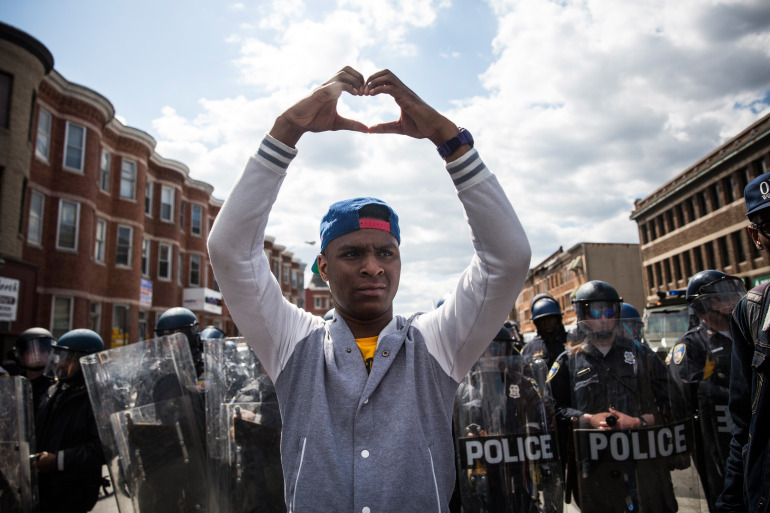
Nearly a year after protests shut down the city, we're starting to see signs of positive change.
What a difference a year makes. Three-hundred sixty-five days after the arrest and death of Freddie Carlos Gray, we are now remembering, reflecting, still asking, “Has anything changed?”
The houses and buildings of Pennsylvania and North avenues , where the unrest took place, have been dilapidated for many, many years. Penn-North, as we call the intersection here, is a shadow of its former glory. Historically, Penn-North was the epicenter in the city for profitable Black businesses, an unforgettable night scene, surrounded by thriving Black communities. Penn-North hosted many of the greats—musicians, performers, activists, and the like, from all around the country, making it the heart of Black Baltimore. It was the beacon of light and hope in the midst of our struggle in this city.
But over the years, something happened. The music stopped, the lights were turned off, and those thriving communities diminished. Businesses up and down the strip closed. Drugs came in and the people moved out, and for those who stayed, their community, our light, was extinguished. Penn-North became an afterthought of blight, hopelessness, and despair.
Three-hundred sixty-five days ago, there wasn’t much to talk about in Penn-North. Three-hundred sixty-five days later, Penn-North is the talk of the town. However this time it’s as the catalyst for reshaping the city's landscape and history in a way no city planner could have ever imagined.
That time of chaos and uncertainty, locally termed as just “Freddie Gray,” was more than just a moment.
During that 15-day period, from April 12, 2015, when Freddie Gray was arrested, to April 19 where he died, to April 27, the day of his funeral and the unrest, all that we wished to not see and everything that we wished to not believe had been uprooted, leaving us with the grim view of our current reality. It was more than buildings burning, protestors marching, and police in riot gear. The Freddie Gray tragedy was deeper.
It was a moment that showed the magnitude of pain in the black community. A pain that runs so deep that only the comforting principles of truth and justice can relieve it. A pain that is a constant companion of every man, woman and child, not just in Penn-North but throughout Baltimore. It is a pain that has the power to diminish the spirit of human beings daily under the weight of its depth. It takes only a hammer and nail to fix disregarded property, but more is required to restore broken human beings. Freddie Gray was a moment of clarity that the pain is real and the people wanted change.
 Three-hundred sixty-five days later, there are new conversations taking place in the Baltimore City Public School System about how to strengthen student voice and support student activism. In the police department, training policies are being reevaluated, the Law Enforcement Officer Bill Of Rights is being questioned and reviewed, and the department is trying to change its relationship with the people. And in City Hall, in the wake of the unrest, an incumbent Mayor has decided not to run, leaving the field wide open for more experienced leadership and new ideas. But the most significant change has been the rise of consciousness of the next generation.
Three-hundred sixty-five days later, there are new conversations taking place in the Baltimore City Public School System about how to strengthen student voice and support student activism. In the police department, training policies are being reevaluated, the Law Enforcement Officer Bill Of Rights is being questioned and reviewed, and the department is trying to change its relationship with the people. And in City Hall, in the wake of the unrest, an incumbent Mayor has decided not to run, leaving the field wide open for more experienced leadership and new ideas. But the most significant change has been the rise of consciousness of the next generation.
There are more young organizers and activists on the ground like never before, working to restore the “hoods” that have been destroyed by tyranny and oppression. And the call for a youth-led, youth-oriented movement based on equity, peace, and justice continues to grow louder. As I have been taught, now is the time that we have to begin the serious process of putting human beings together with the mortar of truth and justice, and the love of one another. These principles serve as the foundation for making our communities safe and decent places to live.
Finally, you will be seeing this crop of young leaders, my comrades, take the struggle to the next level by expanding the fight from Black lives to Latino lives, to LGBT lives, and to other marginalized and disenfranchised populations. We are challenging the old thinking, old ways, and old systems that have locked us in a slave-master relationship, against our own interests, to our own detriment. We are breaking the chains. This is what Freddie Gray has produced.
So, as the city continues to learn from April 2015, we must never forget this moment by embracing it.
We embrace the seriousness of a grueling, hotly contested battle within the mayoral and City Council elections that has generated record-setting voter turnout. We embrace the weight of coming out of the most violent year in 20 years. We embrace the fight to seek justice for Freddie Gray’s life by holding those officers involved accountable in the courts. We embrace hope for change in policies, relationships, and structures that have compelled all of us to act in spite of the possibility of unfulfilled expectations.
Three-hundred sixty-five days later, we embrace it all, as this is our new reality, this is the new Baltimore after Freddie Gray.
What a difference a year makes.